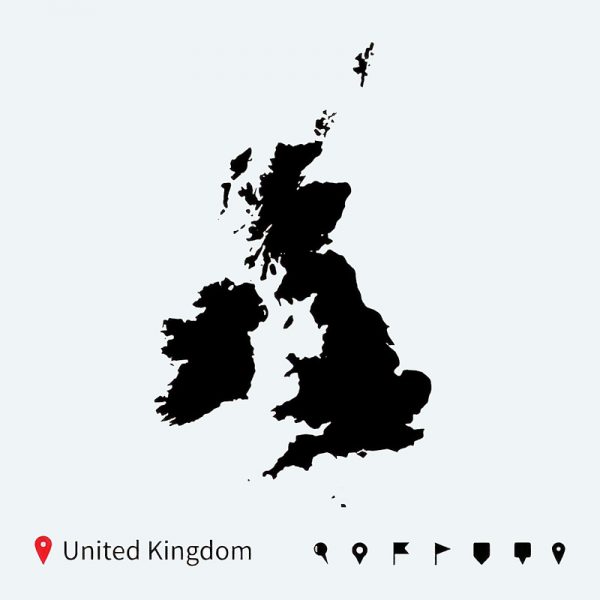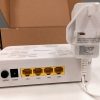BDUK – Q3 2019 Superfast Broadband Take-up by UK Region

The Government’s £1.8bn Building Digital UK scheme has now helped to extend “superfast broadband” (24Mbps+) ISP networks to 5,198,436 extra UK premises since 2012/13 and the latest take-up data to September 2019 shows demand from consumers continues to climb, reaching just over 70% in some counties.
As usual the figures below reflect the percentage % of homes and businesses that have chosen to take a superfast broadband service (usually via FTTC, FTTP or Fixed Wireless Access technology), albeit specifically those which have been delivered via state aid support from the BDUK programme (i.e. % subscribed of premises passed).
The data is split between the first two phases of the programme and the most recent contracts have tended to focus on remote rural areas, which since around 2017/2018 have increasingly involved deployments of “full fibre” (FTTP) ultrafast broadband networks to reflect the Government’s strategy.
Advertisement
We should add that older BDUK contracts defined “superfast” as offering download speeds of 24Mbps+, while recent ones have increased this to 30Mbps+ in order to align with the definition used by Ofcom and the EU.
BDUK Phases One (Finished Spring 2016)
Supported by £530m of public money via the Government (mostly extracted from a small slice of the BBC TV Licence fee), as well as significant match funding from local authorities and the EU. The public funding is then roughly matched by BT’s private investment. Overall it helped to extend “superfast broadband” (24Mbps+) services to cover 90% of premises in the United Kingdom.
BDUK Phase Two (Technically on-going)
Supported by £250m of public money via the Government, as well as match funding from local authorities, Local Growth Deals and private investment from suppliers (e.g. BT, Gigaclear, Airband, Call Flow etc.). This phase extended superfast broadband services to 95% of premises in time for the end of 2017, although some contracts are on-going until late 2020 and will reach beyond 95%.
The BDUK contracts include a clawback (gainshare) clause, which requires the suppliers to return part of the public investment as customer adoption of the new service rises. The funding can then be reinvested to further improve network coverage and speeds via future deals. Efficiency savings from earlier contracts can also be reinvested.
So far it looks as if a total of around £712m could in theory be returned via clawback from BT (here) and more than £200m (Jan 2018 figure – more recent data has not been given) from efficiency savings, which may rise again in the future. BDUK has estimated that this reinvestment might be enough to boost the UK coverage of 24Mbps+ capable networks to around 97% by March 2020 and possibly 98%+ after that, but this is not an official target.

Advertisement
The Universal Service Obligation (USO) mentioned above is a reference to the Government’s new legally-binding pledge to ensure that those in the final 2-3% of premises, which may not benefit from BDUK’s effort, can request a download speed of at least 10Mbps. This is due to be introduced from March 2020 (details here).
BDUK Phase One Take-up (Average %)
The following tables break the take-up data down by each BDUK local authority (project area) and devolved region (Scotland, Wales etc.), although for the proper context these percentages should ideally be considered alongside the most recent premises passed (network coverage) data, which can be seen at the bottom of this article. Overall 61.48% premises have adopted the new service (up from 59.58% in June 2019).
NOTE: Some of the counties have divided their deployments into separate contracts. For example, Phase One in Shropshire doesn’t include the ‘Telford and Wrekin‘ area because that is part of a separate Phase Two contract inside the same county. On top of that the contracts were all signed at different times and so are at different stages of development.
| Project Area (BDUK Phase 1) | Uptake % (Mar 2019) | Uptake % (Jun 2019) | Uptake % (Sep 2019) |
| Berkshire Councils | 63.7 | 65.5 | 67.21 |
| Buckinghamshire and Hertfordshire | 66.5 | 68.9 | 71.11 |
| Cambridgeshire, Peterborough | 61 | 62.9 | 64.97 |
| Central Beds, Bedford Borough, Milton Keynes | 66.1 | 68.6 | 70.55 |
| Cheshire East, Cheshire West & Chester, Warrington, Halton | 63.4 | 65.5 | 67.78 |
| Devon & Somerset (including, Plymouth, Torbay, North Somerset, Bath & NE Somerset) | 57.7 | 60 | 62.13 |
| Coventry, Solihull, Warwickshire | 65.6 | 67.7 | 69.51 |
| Cumbria | 58.3 | 60.6 | 62.92 |
| Derbyshire | 56.5 | 58.9 | 61.03 |
| Dorset, Bournemouth and Poole | 57.6 | 60 | 61.98 |
| Durham, Gateshead, Tees Valley and Sunderland | 56.5 | 58.9 | 61.07 |
| East Riding of Yorkshire | 60.7 | 63.2 | 65.5 |
| East Sussex, Brighton and Hove | 63.3 | 65.4 | 67.35 |
| Essex, Southend-On-Sea, Thurrock | 62.5 | 64.8 | 66.95 |
| Greater Manchester | 52.1 | 55.1 | 58.27 |
| Hampshire | 60.4 | 62.6 | 64.62 |
| Herefordshire and Gloucestershire | 57.6 | 59.7 | 61.75 |
| Isle of Wight | 55.5 | 58.1 | 60.43 |
| Kent and Medway | 61.1 | 63.2 | 65.58 |
| Lancashire, Blackpool, Blackburn with Darwen | 54.5 | 56.8 | 59.32 |
| Leicestershire | 61.6 | 63.8 | 65.86 |
| Lincolnshire | 60.7 | 63 | 65.18 |
| Merseyside | 50.4 | 53 | 56.15 |
| Newcastle upon Tyne | 52.8 | 55 | 57.89 |
| Norfolk | 60.6 | 62.8 | 65.26 |
| North Lincolnshire, North East Lincolnshire | 59.1 | 61.2 | 63.3 |
| North Yorkshire | 58.2 | 58.2 | 58.21 |
| Northamptonshire | 64.5 | 66.8 | 68.68 |
| Northumberland | 61.8 | 63.7 | 65.78 |
| Nottinghamshire | 60.3 | 62.2 | 64.3 |
| Oxfordshire | 64.5 | 66.6 | 68.15 |
| Rutland | 67.3 | 67 | 68.47 |
| Shropshire | 58.7 | 61.3 | 63.47 |
| Staffordshire and Stoke-on-Trent | 57.9 | 59.8 | 61.91 |
| Suffolk | 62.2 | 64.4 | 66.39 |
| Surrey | 64.8 | 66.6 | 68.2 |
| West Sussex | 64.6 | 66.7 | 68.59 |
| West Yorkshire | 55.4 | 57.8 | 60.43 |
| Wiltshire | 62.6 | 64.8 | 66.76 |
| South Gloucestershire | 64.6 | 66.5 | 67.85 |
| Worcestershire | 63.3 | 65.8 | 67.82 |
| Devolved Administrations | |||
| Highlands and Islands | 57.7 | 60.1 | 62.49 |
| Northern Ireland | 66 | 67.7 | 69.39 |
| Rest of Scotland | 52.6 | 55.2 | 58.01 |
| Wales | 51.8 | 51.8 | 51.77 |
BDUK Phase Two Take-up (Average %)
So far in this phase an overall total of 46.79% of premises have adopted the new service (up from 44.02% in June 2019), although some projects have yet to report. We note that a number of Phase 2 schemes also consist of more than one contract and so you may see several figures being reported for certain areas in order to reflect each of those deals (this is sadly very confusing but that’s just how they do it).
Advertisement
| Project Area (BDUK Phase 2) | Uptake % (Mar 2019) | Uptake % (Jun 2019) | Uptake % (Sep 2019) |
| Berkshire | 26, 6, 22.2 | 26, 3.7, 27.4 | 27.66 ,5.62, 31.66 ,2.17 |
| Black Country | 40.9 | 44.2 | 48.24 |
| Bucks & Herts | 45 | 47.2 | 50.02 |
| Bedfordshire & Milton Keynes | 46 | 48.2 | 52.79 |
| Cambridgeshire | no data | no data | no data |
| Cheshire | 49.5 | 51.9 | 56.49 |
| Cornwall | 48, 23.6 | 51.1, 24.1 | 53.53, 29.41 |
| Cumbria | 41.8 | 44.3 | 47.61 |
| Derbyshire | 38.2 | 40.5 | 41.64 |
| Devon & Somerset | 10.1, 4, 24 | 10.1, 5, 26 | 10.13, 10.3 |
| Dorset | 52.9, 1.4 | 57.1, 8.4 | 60.4, 14.6 |
| Durham | 42.1 | 46.1 | 50.22 |
| East Riding (Yorkshire) | 53.1 | 55.1 | 57.78 |
| East Sussex | 51.3 | 54.1 | 58.27 |
| Essex | 44.5, 34, 9, 0.7 | 48.2, 26.6, 2, 13.9, 0.3 | 53.07, 26.61, 2, 17.29, 8.65 |
| Greater Manchester | no data | no data | no data |
| Hampshire | 42.5 | 45.7 | 48.21 |
| Herefordshire & Gloucestershire | 38, 11.3, 5, 4,11.4, 12.3 | 37.4, 6, 11, 6.7, 3.2, 16.7, 18.7 | 37.42, 13.77, 12.95, 9.85, 1.61, 21.42, 38.44 |
| Kent | 55.4 | 59.9 | 63.61 |
| Lancashire | 41.1 | 42.8 | 44.54 |
| Leicestershire | 41.4 | 45.2 | 49.06 |
| Lincolnshire | 42 | 44.9 | 48.1 |
| Norfolk | 49.8 | 52.4 | 54.87 |
| North Lincolnshire | 43.1 | 46.2 | 46.22 |
| North Yorkshire | 56.4, 11.6 | 56.4, 14.7 | 56.36, 22.03 |
| Northamptonshire | 50.5, 11, 23 | 53.7, 12.9, 11.8 | 56.93, 10.75, 12.06 |
| Northumberland | 45.6 | 49.8 | 50.18 |
| Nottinghamshire | 44.7 | 47 | 47, 2.79 |
| Oxfordshire | no data | no data | no data |
| Rutland | no data | no data | no data |
| Shropshire | 43.6, 2.2 | 47.1, 2.2 | 52.04, 1.7 |
| South Gloucestershire | 47.6, 19.9 | 50.8, 23.9 | 54.58, 21.07 |
| South Yorkshire | 43.4 | 46.7 | 50.4, 2.94 |
| Staffordshire | 43.4 | 44.4 | 47.13 |
| Suffolk | 49.5 | 51.4 | 54.99 |
| Swindon | 9 | 9 | 8.68 |
| Telford & Wrekin | 55.7 | 59.7 | 63.45 |
| Warwickshire | 45.8, 1.1 | 46.9, 6 | 68.15, 8.42 |
| West Oxfordshire | 7 | 8 | 11.09 |
| West Sussex | 47 | 52.8 | 54.76 |
| West Yorkshire | 40.8 | 42.3 | 45.26 |
| Wiltshire | 46.7, 4.4 | 50.6, 0.9, 16.5 | 53.61, 0.93, 19.73 |
| Worcestershire | 51.7 | 53.9 | 55.42, 13.87 |
| Devolved Administrations | |||
| Highlands and Islands | no data | no data | no data |
| Northern Ireland | 42.9 | 46.2 | 49.16 |
| Rest of Scotland | no data | no data | no data |
| Wales | no data | no data | no data |
IMPORTANT: Take-up is a dynamically scaled measurement, which means that at certain stages of the scheme it may go up or even down depending upon the pace of deployment (i.e. premises passed in any given time-scale), although over time the take-up should only rise.
Explained another way, earlier phases of the roll-out were easier and faster to deploy, so you could expect to see a bit of a yo-yo movement with the take-up % sometimes falling if lots of new areas were suddenly covered. Some contracts are also younger than others and will thus take time to catch-up. On top of that BDUK’s roll-out pace has slowed to a crawl as it reaches remote rural areas, which will give take-up a chance to climb.
A number of other factors can also impact take-up, such as the higher prices for related “fibre” services, as well as customers being locked into long contracts with their existing ISP (they can’t upgrade immediately) and a lack of general awareness (locals don’t always know that the faster service exists) or interest in the new connectivity (if you have a decent ADSL2+ speed and only basic needs then you might feel less inclined to upgrade).
The fear of switching to a different ISP may also obstruct some services. In other cases the new service may run out of capacity (i.e. demand is higher than expected), which means that people who want to upgrade are prevented from doing so until Openreach resolves the problem, although the scale of this issue is fairly small.
Now, for some context, here’s the latest progress report on related contracts for the same period (this excludes related match-funding from private investment). Take note that the figures shown below are 3 months behind those above as BDUK has yet to update them (June 2019 figures).
Funding and Premises Passed Progress (BDUK Phase 1 + 2)
| Total BDUK Contracted Funding | Total LB Contracted Funding | Current Total Contracted Premises | Delivered to Date (Jun 2019) | |
| Bedford & Milton Keynes | £8,130,000 | £9,443,694 | 56,269 | 50,745 |
| Berkshire | £5,153,017 | £4,603,250 | 43,741 | 31,886 |
| Black Country | £2,988,349 | £2,988,349 | 39,109 | 37,350 |
| Bucks & Herts | £10,837,000 | £11,415,000 | 94,428 | 88,616 |
| Cambridgeshire | £8,250,000 | £21,895,592 | 111,213 | 103,844 |
| Cheshire | £6,461,000 | £16,091,055 | 82,468 | 82,210 |
| Cornwall | £5,960,000 | £12,529,786 | 14,988 | 12,795 |
| Cumbria | £19,959,519 | £18,798,000 | 120,065 | 120,885 |
| Derbyshire | £9,579,550 | £9,580,000 | 103,755 | 96,651 |
| Devon & Somerset | £39,326,673 | £28,331,742 | 297,025 | 294,872 |
| Dorset | £13,741,841 | £12,349,470 | 80,085 | 77,445 |
| Durham | £12,786,267 | £11,763,000 | 112,898 | 111,817 |
| East Riding (Yorkshire) | £10,507,459 | £5,193,079 | 49,510 | 49,753 |
| East Sussex | £13,640,000 | £13,000,000 | 70,040 | 63,694 |
| Essex | £14,254,755 | £19,296,658 | 158,848 | 132,967 |
| Greater Manchester | £3,440,000 | £5,923,000 | 41,363 | 40,062 |
| Hampshire | £15,262,307 | £14,220,615 | 106,434 | 99,212 |
| Herefordshire & Gloucestershire | £31,090,658 | £27,305,290 | 152,367 | 130,263 |
| Hertfordshire | £0 | £879,471 | 546 | 0 |
| Highlands & Islands | £50,830,000 | £75,600,000 | 149,730 | 149,799 |
| Isle of Wight | £2,490,000 | £2,490,000 | 17,617 | 17,649 |
| Kent | £17,063,509 | £14,998,391 | 137,881 | 138,202 |
| Lancashire | £14,670,000 | £22,540,000 | 147,334 | 145,892 |
| Leicestershire | £7,968,895 | £10,884,647 | 75,316 | 72,760 |
| Lincolnshire | £16,110,000 | £17,910,000 | 139,985 | 134,321 |
| Merseyside | £5,460,000 | £4,374,000 | 43,905 | 43,966 |
| Newcastle | £970,000 | £941,158 | 6,760 | 6,697 |
| Norfolk | £24,650,000 | £35,099,125 | 212,687 | 198,638 |
| North Lincolnshire | £4,181,242 | £1,880,963 | 29,442 | 29,344 |
| North Yorkshire | £28,160,000 | £14,654,726 | 175,283 | 168,882 |
| Northamptonshire | £9,856,669 | £11,009,000 | 79,349 | 74,917 |
| Northern Ireland | £11,454,000 | £21,954,000 | 66,907 | 67,173 |
| Northumberland | £10,687,867 | £11,986,750 | 49,620 | 48,296 |
| Nottinghamshire | £7,850,000 | £9,288,644 | 67,387 | 67,429 |
| Oxfordshire | £8,184,500 | £20,045,470 | 79,882 | 78,274 |
| Rest of Scotland | £50,000,000 | £107,575,000 | 581,999 | 582,406 |
| Rutland | £1,000,000 | £1,670,000 | 10,004 | 9,835 |
| Shropshire | £19,317,466 | £12,722,000 | 69,782 | 66,677 |
| South Gloucestershire | £3,370,000 | £3,521,123 | 21,673 | 19,267 |
| South Yorkshire | £10,395,000 | £13,353,577 | 104,222 | 95,687 |
| Staffordshire | £9,620,000 | £7,440,000 | 82,069 | 80,536 |
| Suffolk | £26,940,000 | £26,044,703 | 126,812 | 123,207 |
| Surrey | £1,310,000 | £19,020,081 | 78,245 | 78,390 |
| Swindon | £950,000 | £950,000 | 20,138 | 17,010 |
| Telford & Wrekin | £2,157,000 | £1,843,000 | 8,822 | 8,698 |
| Wales | £69,040,000 | £180,651,507 | 754,791 | 701,032 |
| Warwickshire | £14,557,172 | £14,557,172 | 74,301 | 61,322 |
| West Oxfordshire | £1,600,000 | £1,556,675 | 4,788 | 2,438 |
| West Sussex | £8,011,243 | £7,510,000 | 54,533 | 53,617 |
| West Yorkshire | £11,019,827 | £11,175,487 | 103,485 | 96,064 |
| Wiltshire | £9,270,000 | £16,496,000 | 83,324 | 75,627 |
| Worcestershire | £4,497,032 | £11,390,000 | 64,121 | 59,317 |
| £695,009,817 | £958,740,250 | 5,457,346 | 5,198,436 |
The above figures only include 24Mbps+ capable premises in BDUK intervention areas.
Mark is a professional technology writer, IT consultant and computer engineer from Dorset (England), he also founded ISPreview in 1999 and enjoys analysing the latest telecoms and broadband developments. Find me on X (Twitter), Mastodon, Facebook, BlueSky, Threads.net and Linkedin.
« 2019 vs 2015 Netflix UK Video Streaming Broadband ISP Speed Index





















































Comments are closed